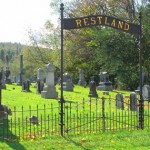Graveyard Rabbits and others interested in headstone iconography will enjoy the latest edition of Common-place, The Interactive Journal of Early American Life. In Object Lessons, Digging Up History, Edward E. Andrews describes “how Photo-Flo and elbow grease are saving New England’s historic cemeteries.”
“Poor George,” we grunted as we looked down to survey the damage. George was hurting. His face was flat on the ground and, while ants and shoots of uncut grass explored ways to migrate around his heavy, white body, layers of mold and errant pine needles concentrated in the decaying crevices on his back. . . As my colleague and I stood over George, contemplating the best way to clean him up, it occurred to us that we were using the word him to describe what was really an it.“George” was not an actual person, but a gravestone that memorialized a person’s life and mourned his death.
The article describes cemetery preservation projects along with a brief discussion of headstone materials and restoration practices. Andrews goes on to describe a web project documenting Newport Rhode Island’s black burial ground, “God’s Little Acre, and the relationships between gravestone art and society, the ways that gravestones “reveal larger attitudes about the meaning of death itself.” He brings the discussion back to “Poor George” by analyzing the marker and inscription as “a commentary on the perils of westward migration and family disruption.”
When my high school English students read The Scarlet Letter, I introduced a special unit on Puritan gravestones and cemeteries. Students were required to analyze the symbolic meaning of the engraved stones, mostly the traditional urns, willows, death’s head, hourglass, and angels. We didn’t do too much with the inscription itself. Andrews’ interpretation of the brief lines on George McIntire’s headstone take iconography a step further.
Without knowing the cause of his death in September 1865 in Cinncinnati, Ohio, Andrew offers the idea that the marker notes McIntire’s death as a “bad death,” one where the deceased was in social isolation from his family. McIntire is buried in the First Congregational Church cemetery in Wellesley, Massachusetts, some distance from Cinncinnati. The inscription reads
No mother stood beside his couch,
To cheer his dying bed;
No sister there with kindly hand,
To bathe his aching head
Andrews reads this as a cautionary tale for other young men, “In the end, the stone is not really about McIntire, but about the anxieties and fears that migration might cause for all members of a family.”
I find this a fascinating approach to studying gravestones, and encourage you to visit Common-Place and read the entire article. I am going back to look at the photos of my ancestors’ gravestones with a new ear to what they may be saying.
Common-Place is an online newletter sponsored by the American Antiquarian Society and The University of Oklahoma features scholarly articles on a wide variety of subjects related to Early American life.






Marian and Pauleen, yes, the full understanding of gravestone symbolism is an interesting field. I think we could learn a lot from a closer look. Glad to find a fellow fan of Common-Place!
Gr8Dame, You have a good mystery on your hands. Any chance of further research? I would love to hear the full story.
What a neat idea… a week or so ago, I posted a gravestone mystery on another blog, but will repeat it here as the context seems appropriate. When I was a young child, my mother used to take me "grave yard exploring". Once we found two graves near each other, dated early 1700s as best my childish mind can recall. One stone said "Here lies Elizabeth, who was the wife of Simeon Peabody.' The other said, "Here lies Lilliput, who should have been the wife of Simeon Peabody." The wording may be slightly off, but not the gist of it! There were numerous Peabodys all around – and the women were close in age and died within a year or so of each other. Nowhere could we find Simeon, although we looked. There must be a story there someplace!
Thanks for bringing this to a wider audience. I've read the article and it certainly is intriguing. A new lens with which to look at the gravestones we see.
I haven't read the article yet though I did take note of it when Common Place came out. I agree with you that this is fascinating! I have considered gravestones from the point of view of genealogical information, artistic symbolism and the materials they are made from. But I have never really given much attention to the epitaphs. Now you have convinced me. This is fascinating – especially the way he derived his conclusions without knowing the cause of death. But really the cause of death doesn't have much bearing on what the author is saying. It's the isolation from migration that's important. He's absolutely right that these early gravestones served the purpose of warning the living.